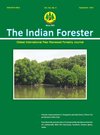Ecosan (Ecological Sanitation) Based Agroforestry for Boosting Rural Livelihoods
DOI:
https://doi.org/10.36808/if/2016/v142i9/102537Keywords:
Livelihoods, ECOSAN, Agroforestry.Abstract
The earlier 'Nirmal Bharat Abhiyan' (NBA) and the recent 'Clean India Mission', for promotion of safe sanitation has been the only driving force for this article, which pertains to synergistic union of ECOSAN (Ecological sanitation) with Agroforestry. Various constraints and limiting factors affecting rural livelihoods have been elaborated to highlight the importance of this issue, which advocates for the use of recycled human excreta (urine and faeces) for optimizing the land resource use efficiency through Agroforestry. The benefits, relevance and intricacies of ECOSAN have been reproduced to sensitize the stakeholders for its adoption in Agroforestry systems.
 Suitable tree-crop combinations have been recommended for the different regions of India. The examples and database of enhancement of farm production through use of nutrient rich Human excreta, recycled by ECOSAN, as manure have been reproduced through comparative studies of human excreta vis-à -vis conventional fertilizers. This recommendation for innovative Agro forestry is expected to be an incredible cost-effective option to boost the rural livelihoods of India,which suffer a lot due to multidimensional setbacks. Keeping in view the taboos for use of human excreta, only three categories of Agroforestry Systems have been recommended under: Silvi-pastoral, Horti-pastoral and Silvi-horti-pastoral systems. It is expected that the proposed synergistic integration of Agroforestry with ECOSAN would revolutionize the rural livelihoods beside supholding the dignity of rural populations by ensuring a hygienic and eco friendly sanitation system. The free inputs for Agroforestry would substantially boost rural economy as well by cutting down the expenses of fertilizers.
References
Anon (2001). Report of the task force on greening India for livelihood security and sustainable development, Planning Commission, Govt. of India, pp: 231.
Anon (2006). Guidelines for the safe use of wastewater, excreta and grey water, Vol-4, Excreta and gray water use in agriculture, WHO, pp:182.
Anon (2009). UNICEF/WHO, "Diarrhoea: why children are still dying and what can be done," ed: World Health Organization – Official Website., 2009.
Anon (2011). Water Aid in Nepal: Technical handbook-Construction of ecological sanitation latrine, pp: 60, Available at www.nepal.wateraid.org.
Balkema A.J., Preisig H.A., Otterpohl R. and Lambert F.J. (2002). "Indicators for the sustainability assessment of wastewater treatment systems,"Urban water, 4: 153-161.
Chariar V.M. and Ramesh Sakthived S. (2011). Ecological Sanitation: Practitioner's Hand Book, Govt. of India and UNICEF, pp:192.
Esrey S., Anderson I., Hillers A. and Sawyer R. (2001). Closing the Loop : Ecological sanitation for food security, pp:96. Available at http://www.ecosanres.org/pdf_files/closing-the-loop.pdf.
Esrey SA P.J., Roberts L. and Shiff C. (1991). "Effects of improved water supply and sanitation on ascariasis, diarrhoea, dracunculiasis, hookworm infection, schistosomiasis, and trachoma," Bull World Health Organ, 69: 609-621,
Fewtrell L., Kaufmann R. B., Kay D., Enanoria W., Haller L., and Colford Jr J.M.. (2005). "Water, sanitation, and hygiene interventions to reduce diarrhoea in less developed countries: a systematic review and meta-analysis", The Lancet Infectious Diseases, 5:42-52.
Jonsson H., Richert Stintzing A., Vinnerås B. and Salomon E. (2004). Guidelines on the Use of Urine and Faeces in Crop Production. EcoSanRes Publication Series. Report 2004-2. Stockholm Environment Institute: Stockholm, Sweden. Available at www.ecosanres.org.
Lim ML W.M. (2004). "Infectious diarrhea in history," Infectious Disease Clinics of North America, 18: 261–274.
Morgan P. (2003). Experiments using urine and humus derived from ecological toilets as a source of nutrients for growing crops. http://aquamor.tripod.com/KYOTO.htm.
Pandey D.N. (2007). Multifunctional agroforestry systems in India, Curr. Sci., 92(4): 455-463.
WHO (2006). Guidelines for the Safe Use of Wastewater, Excreta, and Greywater Volume 4: Excreta and Greywater Use in Agriculture, pp:182.
Downloads
Downloads
Published
How to Cite
Issue
Section
License
Unless otherwise stated, copyright or similar rights in all materials presented on the site, including graphical images, are owned by Indian Forester.





